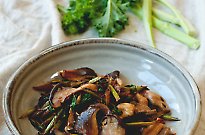
Going green in the kitchen

10 ways to 'greenify' your life
In a world where we’re all time-poor, maintaining a kitchen that’s healthy, green and ‘alive’ can seem like an impossible dream. But according to Rosie Percival, Melbourne co-author of Martha Goes Green: a vegetarian cookbook, going green in the kitchen isn’t as tricky as we might think
“Not at all. It seems like these days there’s been a huge eco and green explosion,” she says. “You see it in magazines and everywhere when you go to the shops, everything’s eco-friendly. In the supermarket there’s recycled bags, reusable bags – it’s everywhere. I don’t think it’s hard at all.”
So what are some simple ways for people to start becoming more green in the kitchen? Rosie says going meat-free is important – as raising animals for human consumption uses a huge amount of water and environmental resources.
“I think one of the biggest things is going vegetarian. But some people think that’s unrealistic, so baby steps are good, even by just reducing your intake of meat.”
Rosie herself is vegan, but says anything you can do to reduce your meat intake is a great step. I think being vegan is the ultimate consumer boycott of all that stuff out there, but I think going vegetarian is an easy first step. And I think as you learn more about the environment and health, going vegan is the next step, it’s a natural progression. More than anything, it’s about having a conscious mindset, being aware of what you’re doing.”
Rosie says another way to go green in the kitchen is by eating local foods. That way, there’s less transport, and therefore less pollution and energy use between you and your meal.
“So many of our fruit and vegetables are imported from all around the world,” she says. “Some of these are pretty absurd, like lemons. You can get lemons in your backyard rather than coming all the way from California. So eating locally, if you go to farmer’s markets, or being more aware of where you’re getting your produce from, is hugely helpful.”
Rosie, along with co-author Ruth Friedlander, believes composting is a great idea for going green in the kitchen, as is investing in eco-friendly dishwashing liquid, floor cleaner and surface sprays. They say while it’s a great idea to buy biodegradable bin liners at the supermarket, it also pays to use the ones you’ve got more efficiently by packing in more waste before you put them in your wheelie bin.
Rosie and Ruth’s top tips for going green in the kitchen
1. Think globally, act locally
Support your local economy and reduce your food miles by buying organic, free-range and in-season produce from farmers’ markets or getting fruit and vegetables delivered straight to your door. In many cases the produce will be fresher (which means tastier).
2. Reduce waste
Choose products with less packaging or buy in bulk. Bring your own bags to the supermarket and avoid putting fruit and vegetables into a separate plastic bag; a bunch of bananas don’t need their own bag, they come pre-wrapped by nature itself.
3. Be realistic
Be realistic when shopping for perishable food items. Buy as much as you know you will eat over the next few days and be mindful about how you store it. Pickles, stir- fries and soups are great ways to use up leftover produce.
4. Reuse packaging
Don’t throw away empty jars and containers. Soak jars in hot soapy water to peel off the labels and use them to store dried goods, knick-knacks, homemade preserves and dressings. Plastic containers are great for taking leftover meals to work.
5. Buy second-hand
Get your kitchenware from second-hand charity stores. Not only is this good for the environment and local charities, but your wallet will thank you too.
6. Make your own
Make your own condiments, dressings and pasta sauces. This saves on excess packaging, you won’t be ingesting an overload of preservatives, salt and sugar and there’s nothing like the taste of home made relishes, mayo and tomato sauce.
7. Grow your own
Nothing beats having an authentic garden salad. If space is limited, plant a few herbs and small greens in some flower pots on your front porch or kitchen windowsill. Better still, forgo the flowerpots and use old tin cans and jars instead.
8. Save water
Be mindful of how much water you use during food preparation. Wash your vegetables, fruit and herbs in a bowl rather than rinsing them under a tap. If you’ve boiled vegetables save and freeze the left over water to use later as a light stock for curries, stews, soups and casseroles.
9. Compost
Find a good home for kitchen scraps and reduce your carbon footprint at the same time. If space is limited, invest in a Bokashi bucket (www.bokashi.com.au). It’s a lot easier than most people think, just remember to keep dairy and meat out to avoid a smelly bin.
10. Be mindful
There is a plethora of green literature out there (books, magazines, the internet) and as you become more aware of the many ways to reduce your environmental footprint, the easier it’ll be to live a greener lifestyle.
Next: Try the Green Cooks vegie barbecue or get daily updates on Twitter and Facebook!
Photo credit: iStock


